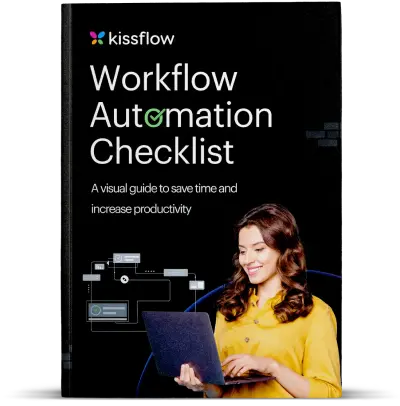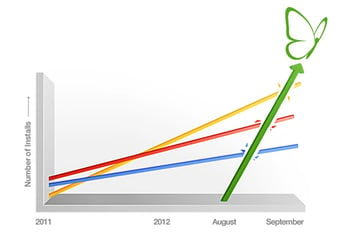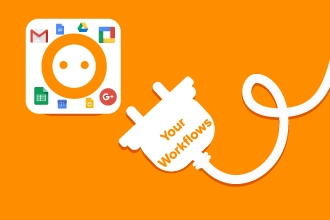
- >
- Workflow >
- How CIOs Use AI Workflow Automation To Accelerate Digital Transformation
How CIOs Use AI Workflow Automation To Accelerate Digital Transformation
Every CIO has heard the mandate: accelerate digital transformation. Make the organization more agile. Improve efficiency. Enable innovation. AI workflow for CIOs has become the critical enabler that makes this possible. And somehow do it all while maintaining existing systems, managing security, and not exceeding budget.
It's an impossible balancing act, except it isn't. Because the CIOs successfully driving transformation aren't doing it through massive platform replacements or years-long enterprise architecture overhauls. They're using digital transformation automation and enterprise AI workflows as the connective tissue that makes transformation actually happen.
The transformation bottleneck nobody talks about
Digital transformation fails for a predictable reason: the gap between vision and execution.
Leadership wants to be data-driven. IT builds amazing analytics dashboards. But the data still lives in 15 different systems that don't talk to each other, requiring manual export, transformation, and consolidation.
Marketing wants to deliver personalized customer experiences. IT implements a state-of-the-art CRM. But the workflows connecting customer data, marketing automation, fulfillment, and support remain disconnected, requiring manual handoffs and duplicate data entry.
Operations wants to be more efficient. IT deploys best-of-breed point solutions. But the processes connecting these solutions are still manual, creating friction at every integration point.
According to recent data, 42 percent of companies abandoned most of their AI initiatives in 2024, up from 17 percent the previous year. The failure rate isn't a technology problem. It's an integration and execution problem.
AI workflow automation solves this by creating intelligent connections between systems, data, and people. It's the missing layer that makes transformation initiatives actually deliver value.
Where successful CIOs focus their workflow automation efforts
The CIOs seeing results aren't trying to automate everything. They're strategic about where workflow automation delivers the highest transformation impact.
Connecting the data ecosystem
68 percent of IT leaders say AI has already reshaped how their organizations operate. But that reshaping isn't about replacing humans with algorithms. It's about connecting previously siloed data and systems.
Leading CIOs use workflow automation to create data pipelines that flow information between systems automatically. When a sales opportunity closes, customer data flows to onboarding systems, provisioning systems, billing systems, and analytics platforms without manual intervention.
When an employee joins, their information populates HR systems, IT systems, facilities systems, and training platforms through automated workflows rather than repeated data entry.
This connected data ecosystem is what enables the analytics, insights, and intelligence that drive transformation. Without it, you're building on a foundation of manual processes and disconnected information.
Scaling AI without scaling complexity
78 percent of enterprises are using AI in at least one business function, and that number is climbing rapidly. But here's the challenge: each AI implementation requires data preparation, model training, deployment, monitoring, and integration with existing processes.
CIOs leverage workflow automation to standardize and scale AI deployments. Instead of custom integration for each use case, automated workflows provide consistent patterns for:
- Data extraction and preparation
- Model deployment and version control
- Prediction serving and result routing
- Exception handling and human-in-the-loop escalation
- Performance monitoring and retraining triggers
This standardization is how you go from three AI pilots to 30 production implementations without multiplying operational complexity.
Enabling citizen developers while maintaining governance
By 2025, citizen developers will deliver 30 percent of AI automation apps. That's not a threat to IT. It's an opportunity, if you have the right framework.
Smart CIOs use low-code workflow automation platform to enable business teams to build their own process improvements while maintaining IT governance and security standards.
The platform provides guardrails: approved integrations, security protocols, data access controls, and deployment standards. Business teams build workflows within those guardrails, moving at the speed they need without creating technical debt or security risks.
This is how you scale digital transformation beyond what your IT team can build directly. You enable the organization to transform itself while IT focuses on platform, architecture, and governance.
The strategic framework for acceleration
The CIOs successfully using workflow automation for transformation follow a consistent strategic approach. Their strategy focuses on acceleration of key initiatives while maintaining operational stability.
Start with process, not technology
The biggest transformation mistakes start with technology. Let's implement this platform. Let's deploy this tool. Then figure out what to do with it.
Successful CIOs start with their most expensive, most broken, or most strategic processes. What's creating the most friction? Where are manual handoffs killing efficiency? What processes are preventing you from executing on strategic initiatives?
Then they ask: what would this process look like if it were fully automated and intelligent? Not just faster, but fundamentally better.
That ideal state becomes the target, and workflow automation becomes the path to reach it.
Build integration layers, not point-to-point connections
Early digital transformation efforts often created integration spaghetti. System A connects to System B. System B connects to Systems C and D. System C connects back to System A. Soon you have hundreds of brittle point-to-point integrations that break whenever anything changes.
Leading CIOs use workflow automation as an integration layer. Systems don't connect directly. They connect through intelligent workflows that:
- Extract data in a standardized format
- Apply business rules and transformations
- Route information to appropriate downstream systems
- Handle errors and exceptions gracefully
- Provide visibility into every integration point
This architecture is how you stay agile. When you need to swap out a system, you modify workflows rather than rebuilding dozens of integrations.
Measure transformation outcomes, not just technical metrics
IT traditionally measures uptime, performance, and technical success. Transformation requires different metrics.
Smart CIOs track:
- Time-to-market for new products or services
- Cycle time for critical business processes
- Cost per transaction across automated workflows
- Employee capacity freed for high-value work
- Revenue or cost impact from automation initiatives
These business metrics tell you whether transformation is actually happening or whether you're just running technology faster.
The organizations reporting 60 percent ROI within 12 months from workflow automation aren't measuring technical efficiency. They're measuring business impact.
The compound effect of connected workflows
Here's what makes workflow automation so powerful for transformation: the benefits compound.
You automate customer onboarding. Faster onboarding means higher conversion rates, better customer experience, and lower support costs. It also means your sales team can handle more volume, your support team can focus on complex issues, and your operations team can plan capacity more accurately.
You connect your data ecosystem. Better data flow means more accurate analytics, faster insights, and smarter AI models. It also means less time spent on data wrangling, fewer errors from manual data movement, and better ability to respond to market changes.
You enable citizen developers. More workflows get automated without burdening IT. But you also build organizational capability, uncover process expertise that was hidden, and create a culture of continuous improvement.
Each improvement makes the next one easier and more valuable.
From pilot to platform
Most transformation initiatives die in pilot purgatory. The proof of concept works. Everyone's excited. Then it never scales.
The difference between successful and failed transformation comes down to platform thinking. CIOs who treat workflow automation as infrastructure rather than projects see dramatically different results.
Platform thinking means:
Building reusable components rather than custom solutions for each use case. Creating templates and patterns that accelerate future implementations. Investing in training and capability building across the organization. Establishing governance frameworks that enable rather than restrict. Planning for scale from day one rather than retrofitting later.
The global workflow automation market growing from $23.77 billion in 2025 to $37.45 billion by 2030 is driven by organizations that figured out platform thinking. They're not buying point solutions. They're building transformation platforms.
The CIO's transformation checklist
If you're serious about using workflow automation to accelerate transformation, start here:
Identify your three most broken processes: Not the most visible. Not the ones leadership keeps mentioning. The ones that are actually creating the most cost, friction, or strategic constraint.
Map the ideal state: What would these processes look like if you could design them from scratch today? No legacy constraints. No "we've always done it this way." Just: what's the best way to accomplish this outcome?
Calculate the gap: What's the difference between current state and ideal state in terms of time, cost, effort, and business impact? That gap is your transformation opportunity.
Start with one: Pick the highest-value, lowest-complexity process. Build it well. Measure everything. Prove the value. Use success to fund expansion.
Build for scale: Even that first workflow should use patterns and components you can reuse. Think platform from day one.
The transformation that compounds
Digital transformation isn't a destination. It's a capability. The capability to identify opportunities, implement solutions, and adapt quickly as conditions change.
AI workflow automation builds that capability systematically. Each automated workflow becomes a building block for the next improvement. Each integrated system expands the connected data ecosystem. Each citizen developer success creates organizational momentum.
The CIOs winning at transformation aren't the ones with the biggest budgets or the most advanced technology. They're the ones who figured out how to connect systems, data, and people through intelligent workflows that make transformation actually happen.
That's not a vision for the future. That's what's possible today. The only question is whether you're building transformation infrastructure or just running faster on the same old processes.
How Kissflow accelerates your digital transformation journey
Digital transformation requires a workflow automation platform that can connect disparate systems, enable rapid process improvement, and scale across the organization without creating technical debt.
Kissflow provides the low-code infrastructure that CIOs need to execute transformation initiatives quickly. Pre-built integrations connect to your existing systems. Visual workflow designers enable business teams to build process improvements without extensive coding. And enterprise-grade governance ensures that rapid innovation doesn't compromise security or compliance.
From connecting your data ecosystem to enabling citizen developers, Kissflow gives you the platform foundation that makes sustainable digital transformation possible.
Accelerate your transformation with intelligent workflow automation
Related Topics:

Kissflow's Complete Guide To Workflow Automation
Thank you for downloading the ebook!
Related Articles











